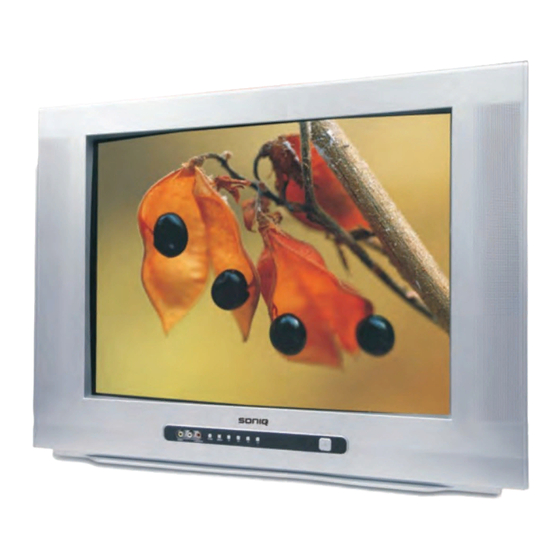
Table of Contents
Advertisement
Quick Links
Advertisement
Table of Contents

Summary of Contents for SONIQ QV290
-
Page 2: Table Of Contents
Dear Customer: Thank you for purchasing our latest TV set. Please read this instruction manual carefully first before operation so that you can use it in a safe and reliable manner and bring all its functions into full play. Please also keep it properly for future reference. Contents I. -
Page 3: Safety And Precautions
Safety and Precautions To ensure safe and reliable operation of the TV set, please observe the following precautions in installation, operation and maintenance. Attention: 1·Pay attention to the power supply cord before installing the TV set. Do not hang anything on the cord, and avoid treading on the cord. 2·The slots on the housing back are designed for ventilation to ensure reliable operation of the TV set and prevent overheating. -
Page 4: Installation
Installation l First read carefully the relevant instructions in “Safety and Precautions”. l Place the TV set in the room where there is no direct sunlight on it. Any light reflecting from the screen will cause fatigue of your eyes. l Use gentle indirect lighting for comfortable watching. -
Page 5: Prepare The Remote Controller
Installation Prepare the remote controller Install the batteries Load two No. 5 batteries into the Remove the sliding cover of remote controller. chamber, with the +/- poles of batters in line with the +/- marks. Precautions in operating the remote controller ●... -
Page 6: Names And Functions Of Controls
Names and Functions of Controls Front of the machine The functions of adjusting buttons and sockets of AV input The adjusting buttons are in the front of the TV (below the picture tube). 1. Main power switch 2. Volume decrease (V-) and increase (V+) 3. -
Page 7: Remote Controller
Names and Functions of Controls Buttons on remote controller 1. Standby Button It controls power on/standby. Press this button once, it will exchange between working mode and standby mode. When TV is in standby mode, it is in the state of low power consumption and the screen is unlight. -
Page 8: Operation For The Whole Machine
Names and Functions of Controls 10. Sleep Button It can set the time of standby for sleeping. The maximum time of sleeping is 120 minutes,when you press it once, the time will reduce 15 or 10 minutes. If you set the time of sleeping,it will delete automatically the set of OFF-TIME. -
Page 9: Start Operation: Watch Tv Programs
TV Operation Start operation: Watch TV programs 1 Select a desired program ●Use the direct Program No. selection buttons Operation method see previous page "buttons on remote controller." ●Use the Program No. Up/Down Button “P+” “P-” buttons Pressing “P+” will select a Program No. in the increasing number; Pressing “P-”... -
Page 10: Program Presetting (Semi Automatic Searching)
TV Operation status. In this status, you can press “MENU” button to stop the searching. At the end of automatic searching, the Program No. will jump automatically to the Program No.0, and set the picture state as "STANDARD", the volume output value will be set as "15". -
Page 11: Basic Operation: Picture And Sound Control
TV Operation Basic operation: Picture and sound selection 1 Mute and screen display Mute The Mute function may be used when you want to receive a call or visitors. When you need mute, press the “MUTE” button on the remote controller, and the screen will display the red characters “MUTE”. -
Page 12: Set Your Desired Picture Mode
TV Operation Output value of every item is average-divided 100 steps: 0~100. After every value of the "PICTURE" menu has been changed that will be stored. If you do nothing during 10 seconds, the TV will exit automatically from the "PICTURE" menu. Note: When the color system of the TV is AUTO and input signal is NTSC system or is forced into NTSC system and the picture is color, the item of TINT will display on the screen, in other situations, there is no item of TINT . -
Page 13: Technical Operation: Single Button Hopping And Language Selection
TV Operation 5. Select “OFF- TIME” option, then use the Volume Down “V-” button to set hour as 22, and use “V+” button to set Min. as 30. 6. Select “ON- TIME” option, then use the Volume Down “V-” button to set hour as 07, and use “V+”... -
Page 14: Setting The Screen Display Language
TV Operation Language, picture remove noise, calendar selection 1. Picture remove noise OPTION LANGUAGE ENGLISH CALENDAR GAME LOTTERY BIOLOGY CLOCK P+/P- : SELECT V+/V- : ADJUST 2. Setting the screen display language Press the “MENU” button of the TV set for many times or press “OPTION” button on the remote controller to show “OPTION”... -
Page 15: Connection With Other Devices
Connect with Other Devices Connect CD, VCD, DVD or other sound, picture and audio or video output devices Video machine, VCD, DVD, game set or other sound and picture output devices VIDEO RF IN RF output To antenna input AUDIO S-VIDEO Video machine, CD, satellite receiver or other sound and picture output devices... -
Page 16: Miscellany
Miscellany Guide to simple trouble-shooting The following phenomena are not necessary faults, and the following checks should be performed first before asking a specialized person for repair. If the cause of fault cannot be found and corrected with this guideline, remove the power plug from the socket and have a specialized person to repair it. -
Page 17: Specification
Miscellany Specification ●I/O interface: RF: antenna 75Ω co-axial ●Receiving system: RF: PAL B/G AV: PAL NTSC4.43MHZ/3.58MHZ ●AV Input:AV1 AV2 ●AV output×1 ●S-Video Input×1 ●YUV Input×1 ●Power consumption: ≤150W ●No. of programs stored: 0-255 ●Power input: AC 240V 50Hz ●CRT: 68cm measured diagonally ●Sound output: ≥4W×2 ●Loudspeaker: 8Ω, 8W×2 15...




Need help?
Do you have a question about the QV290 and is the answer not in the manual?
Questions and answers